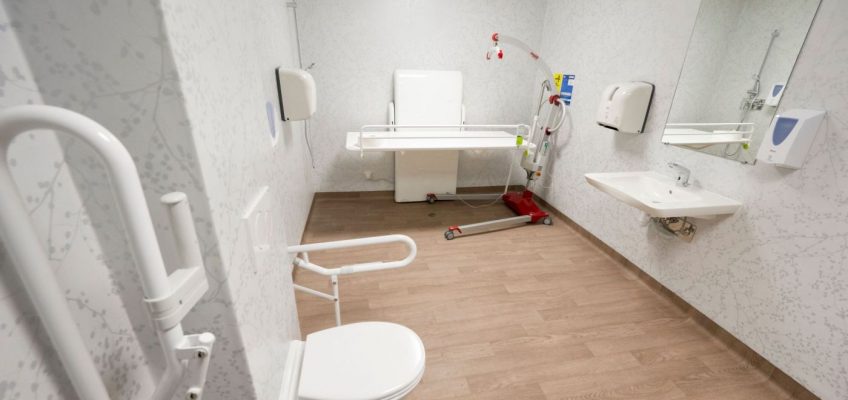By Tony Leys | KFF Health News
ADAIR, Iowa — The blue-and-white highway sign for the eastbound rest stop near here displays more than the standard icon of a person in a wheelchair, indicating facilities are accessible to people who can’t walk. The sign also shows a person standing behind a horizontal rectangle, preparing to perform a task.
The second icon signals that this rest area along Interstate 80 in western Iowa has a bathroom equipped with a full-size changing table, making it an oasis for adults and older children who use diapers because of disabilities.
“It’s a beacon of hope,” said Nancy Baker Curtis, whose 9-year-old son, Charlie, has a disability that can leave him incontinent. “I’m like, ‘Oh my gosh, we’re finally there.’”
The white changing table is 6 feet long and can be lowered and raised with a handheld controller wired to an electric motor. When not in use, the table folds up against the wall.
The table was recently installed as part of a national effort to make public bathrooms more accessible in places like airports, parks, arenas, and gas stations. Without such options, people with disabilities often wind up being changed on bathroom floors, in cars, or even on the ground outside.
Many families hesitate to go out because of the lack of accessible restrooms. “We all know somebody who’s tethered to their home by bathroom needs,” Baker Curtis said. She doesn’t want her son’s life to be limited that way. “Charlie deserves to be out in the community.”
She said the need can be particularly acute when people are traveling in rural areas, where bathroom options are sparse.
Baker Curtis, who lives near Des Moines, leads the Iowa chapter of a national group called “Changing Spaces,” which advocates for adult-size changing tables. The group offers an online map showing scores of locations where they’ve been installed.
Related Articles
Stillwater sophomore goes into cardiac arrest during football practice; family raises money for CPR training
Suni Lee reveals new details about her kidney disease in Glamour woman of the year interview
US school-entry vaccination rates fall as exemptions keep rising
A few rural towns are bucking the trend and building new hospitals
Medicare changes for 2025: What you need to know
Advocates say such tables are not explicitly required by the federal Americans with Disabilities Act. But a new federal law will mandate them in many airports in coming years, and states can adopt building codes that call for them. California, for example, requires them in new or renovated auditoriums, arenas, amusement parks, and similar facilities with capacities of at least 2,500 people. Ohio requires them in some settings, including large public facilities and highway rest stops. Arizona, Illinois, Maryland, Minnesota, and New Hampshire also have taken steps to require them in some public buildings.
Justin Boatner of Arlington, Virginia, advocates for more full-size changing tables in the Washington, D.C., area. Boatner, 26, uses a wheelchair because of a disability similar to muscular dystrophy. He uses diapers, which he often changes himself.
He can lower an adjustable changing table to the height of his wheelchair, then pull himself onto it. Doing that is much easier and more hygienic than getting down on the floor, changing himself, and then crawling back into the wheelchair, he said.
Boatner said it’s important to talk about incontinence, even though it can be embarrassing. “There’s so much stigma around it,” he said.
He said adult changing tables are still scarce, including in health care facilities, but he’s optimistic that more will be installed. Without them, he sometimes delays changing his diaper for hours until he can get home. That has led to serious rashes, he said. “It’s extremely uncomfortable.”
Iowa legislators in recent years have considered requiring adult changing tables in some public restrooms. They declined to pass such a bill, but the discussion made Iowa Department of Transportation leaders aware of the problem. “I’m sorry to say, it was one of those things we’d just never thought of,” said Michael Kennerly, director of the department’s design bureau.
Kennerly oversees planning for rest stops. He recalls an Iowan telling him about changing a family member outside in the rain, with only an umbrella for shelter. Others told him how they changed their loved ones on bathroom floors. “It was just appalling,” he said.
Iowa began installing adult changing tables in rest stops in 2022, and it has committed to including them in new or remodeled facilities. So far, nine have been installed or are in the process of being added. Nine others are planned, with more to come, Kennerly said. Iowa has 38 rest areas equipped with bathrooms.
Kennerly estimated it costs up to $14,000 to remodel an existing rest-stop bathroom to include a height-adjustable adult changing table. Incorporating adult changing tables into a new rest stop building should cost less than that, he said.
Several organizations offer portable changing tables, which can be set up at public events. Some are included in mobile, accessible bathrooms carried on trailers or trucks. Most permanent adult changing tables are set up in “family restrooms,” which have one toilet and are open to people of any gender. That’s good, because the act of changing an adult is “very intimate and private,” Baker Curtis said. It’s also important for the tables to be height-adjustable because it’s difficult to lift an adult onto a fixed-height table, she said.
Advocates hope adult changing tables will become nearly as common as infant changing tables, which once were rare in public bathrooms.
Jennifer Corcoran, who lives near Dayton, Ohio, has been advocating for adult changing tables for a decade and has seen interest rise in recent years.
Corcoran’s 24-year-old son, Matthew, was born with brain development issues. He uses a wheelchair and is unable to speak, but he accompanies her when she lobbies for improved services.
Corcoran said Ohio leaders this year designated $4.4 million in federal pandemic relief money to be distributed as grants for changing-table projects. The program has led to installations at Dayton’s airport and art museum, plus libraries and entertainment venues, she said.
Ohio also is adding adult changing tables to rest stops. Corcoran said those tables are priceless because they make it easier for people with disabilities to travel. “Matthew hasn’t been on a vacation outside of Ohio for more than five years,” she said.
Kaylan Dunlap serves on a committee that has worked to add changing-table requirements to the International Building Code, which state and local officials often use as a model for their rules.
Dunlap, who lives in Alabama, works for an architecture firm and reviews building projects to ensure they comply with access standards. She expects more public agencies and companies will voluntarily install changing tables. Maybe someday they will be a routine part of public bathrooms, she said. “But I think that’s a long way out in the future, unfortunately.”
KFF Health News is a national newsroom that produces in-depth journalism about health issues and is one of the core operating programs at KFF—an independent source of health policy research, polling, and journalism. Learn more about KFF.




